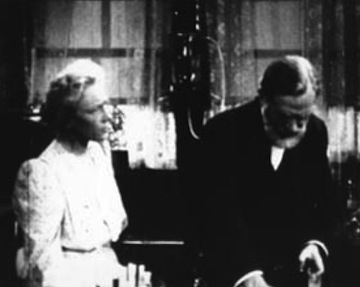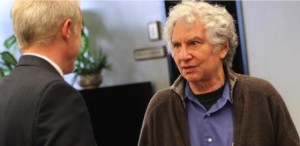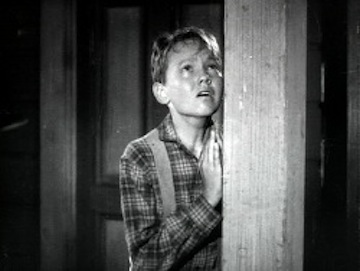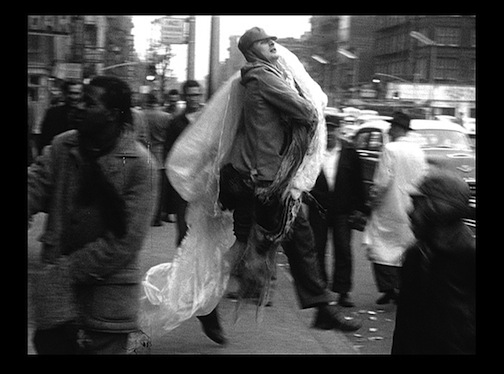Click here to print
Ken Jacobs’s Dissected Doctor’s Dream
posted December 22, 2015

n
Ken Jacobs’s life in film making got a boost from junk in a surplus store.
In the 1970s, he recalls, he visited a “very rundown” Canal Street in Manhattan; in its small shops “a lot of used stuff including government surplus could be bought for pennies on the dollar.”
One day, he wandered into one storefront that was dumping 16mm TV films: “$5 for the reel!”
The only catch was that the store was leaving to customers the task of unwinding all the junk film.
“I reached into a broken cardboard box on the floor and pulled up and paid for two reels without any examination,” Jacobs says from his home in New York state. The tape would provide the raw material for two films, one he declared “perfect,” and another that would become one of his most highly regarded.

Ken Jacobs. Binghamton University
One reel held unedited newsreel footage relating to the assassination of Malcolm X: the hall he’d been speaking in, cops, a television interviewer and witnesses. Having looked at it, says Jacobs, “I uttered the words, ‘perfect film.’ The shots had been strung together for convenience, black tail-ends attached. I released it as a film as-is with the title Perfect Film.” The title was in reality “my only contribution,” he says.
“The second reel was a letdown,” he says. It was “a dull TV period drama called The Doctor. It went on a shelf.” But it didn’t stay there. At the time, Jacobs was teaching film and that second reel sparked an idea for a project for his students in an introductory editing class. His directions to students, he recalls, ran like this:
1) number the shots, beginning to end
2) cut them apart
3) reassemble them beginning with the numerically middle shot followed by the shot that had immediately preceded it followed by the shot that had followed and keep fanning out to either side.
Jacobs says: “I was teaching another class at the time picking up on Vance Packard’s revelations of hidden messages in advertisements and other media, as detailed in The Hidden Persuaders. After looking at the reassembled film I had to suspect my subconscious had been telling me something with the suggestion for the editing exercise!”
 Because, he says, the result of the exercise was striking: “Creepy movie.
Because, he says, the result of the exercise was striking: “Creepy movie.
“We had eviscerated it, turning it inside out, and there were so many unexpected correspondences.” In fact, he says, “a purely taboo inner story was revealed.” In it, “the good doctor was not innocent at all, but had it bad for the sick little girl.” Jacobs wondered whether it might have been this concealed story within “the dreary movie” that had held the attention of the film’s original audiences.
It would have to have done so subliminally. At least, he says, ”I screened the movie for our four-year-old boy and his pal and nothing seemed amiss to them; just a movie.”
The 24-minute, black-and-white film Jacobs and his students made was The Doctor’s Dream; it recently [September 2015] received one of seven 2015 Avant-Garde Masters Grants from The Film Foundation and the National Film Preservation Foundation. The grants are given to institutions that undertake to preserve and make more available important works in American experimental film.
The film that served as the raw material for Jacobs’s film was itself based on a Victorian-era painting in the social realism style, “The Doctor,” held at the Tate Gallery in London. For the 1890 commission, Luke Fildes depicted the death of his own infant son, and the professional devotion of the attending doctor. An engraving from it became hugely popular, selling more than a million copies in the United States.
Jacobs some years ago noted that “the painting itself has an interesting subliminal image appropriate to what’s revealed by my re-editing process of the real, if subliminal, story of the film.” There as in the found film, the hinted sexual event was present “maybe without intention,” he wrote. “But it’s what was gripping in the movie if ever the movie was gripping. In the painting, seen from a little distance, the doctor contemplates the sleeping girl with — you don’t have to agree with this — his curled fist doubling as a penis entering his mouth (I’m sad to find myself so constrained in my speech). Maybe this is the traditional method of smuggling forbidden information, hot stuff, through customs from unacknowledging mind to unacknowledging mind.”
As all this may suggest, Ken Jacobs is no ordinary film maker — and not to be taken quite at face value. Now in his 80s, in 1969 he made the seminal structural film Tom, Tom, the Piper’s Son, which was added to the National Film Registry in 2007, as well as Star Spangled to Death (2004, USA), a film of almost seven hours that, like The Doctor’s Dream, was built from found footage. In the early 1970s he coined the phrase paracinema for his and related cinema experiments. He had, in 1969, started with Larry Gottheim the cinema department at what is now Binghamton University; he retired there in 2003 as Distinguished Professor of Cinema.
Given the manner of the construction of The Doctor’s Dream, its restoration has unsurprisingly been difficult. Michael Kolvek, at Cinema Arts, Inc., in New York, undertook the work and, in an email that Jacobs shared, said the many splices in the original made for “a challenge (to say the least).” He produced a new negative using the liquid gate process, and also re-recorded the original sound from the well-preserved sound on the original print that Jacobs and his students made.

From Ken Jacobs’ “Star Spangled to Death.”
n
For analysts of avant-garde film, The Doctor’s Dream has long provided beguiling viewing. To watch it is “to witness a narrative unfolding forwards and backwards in turns,” Tom Gunning wrote in Millenium Film Journal. The result was “a deconstructive Frankenstein of a film with new vitality in its borrowed parts.”
In his book, A Formalist Theatre (University of Pennsylvania Press, 2011), Michael Kirby described the effect of the film’s odd sequencing; of, for example, images of the doctor and a family waiting, a girl collapsing, and the doctor removing the young boy’s bandages. Kirby wrote: “In watching the traditional narrative film, one forms certain expectations about what will be presented next. These expectations, which may be called structural because they involve the relationship between parts of the film, hold together by their presence extended sections of time and join one moment (when the expectancy is formed) with another (when the expectancy is either confirmed or denied).”
How does this apply to The Doctor’s Dream? Well, for sure it’s not really about a hidden narrative within the film, in any literal sense. Rather, Jacobs is making points about the nature of film and narrative structure, and about how a viewer perceives those. Kirby writes that in watching the reordered film, it quickly becomes apparent that the original was about a son telling a doctor that his sister is sick, and then waiting for a vaccine to take effect. Jacobs’s restructuring serves to realize that “many expectancies in film are conscious, and our savoring of them is part of the dramatic excitement, but many are nonconscious or preconscious.” In other words, “Jacobs exploits, puts pressure upon, and brings to conscious awareness the traditional mechanisms of expectancy structure.” In watching The Doctor’s Dreams, “the time before expectancies are confirmed or denied is increased. Facts must be retained longer. The mind must carry and retain information and expectancies in an unusual, nonhabitual way.” During that process, the former structure becomes, obliquely, “of primary aesthetic importance.”
In this way, Jacobs “demonstrates in The Doctor’s Dream that a structuralist film is ‘about’ structure itself, ‘about’ certain workings in the spectator’s mind. It is not about its subject matter, it is not an interpretation of life or a statement about the world, it does not convey a message, and so forth.”
You mean, it’s not, as Jacobs says, about a hinted sexual event that the original filmmaker inserted, perhaps unconsciously, and that was “what was gripping in the movie, if ever the movie was gripping”?
Perhaps not; but at least, as Jacobs’s odd technique proceeds, writes Paul Arthur in the collection of essays he co-edited, Optic Antics: The Cinema of Ken Jacobs (Oxford University Press, 2011), “an utterly vapid, sententious TV short from the 1950s about a country physician on an urgent house call to a sick child” is reordered so that time is “wrenched out of joint” and “conventional markers of cause and effect are waylaid, producing weirdly expressive conjunctions.”
Arthur does, nonetheless, see what leads Jacobs to…joke?…about the reordered narrative’s revelations of impropriety. When, for example, “the sick girl’s brother watches as she has blood drawn, then in the next shot stands weeping and praying for her deliverance,” viewers might, he allows, at some level of consciousness or subconsciousness ask: “Did the medical procedure cause her demise?” In the course of the muddled film, “poetic themes and unsavory character motives seem to leap from the restirred detritus: an emphasis on time as vision prompted by repeated close-ups of the doctor’s pocket watch and his fiddling over a microscope; the father looking daggers at the benevolent man of science, perhaps for good reason since his bedside manner takes on a treacly erotic dimension”…
— Peter Monaghan
Ken Jacobs was the subject of an extensive 1999 interview in The University Of California at Berkeley’s series of Conversations With History, which is online.
Printed from Moving Image Archive News: http://www.movingimagearchivenews.org
URL to article: http://www.movingimagearchivenews.org/ken-jacobss-dissected-doctors-dream/
Click here to print